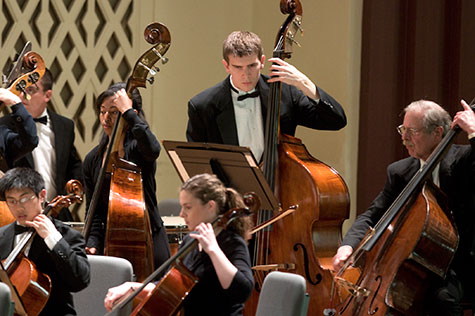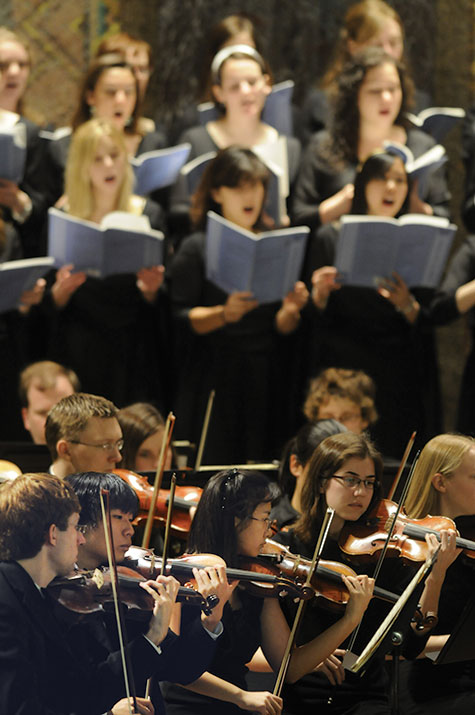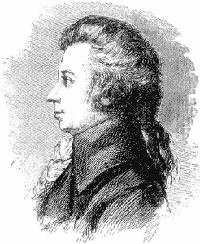
A mysterious stranger arrives with a mysterious commission. The fevered composer fears the work may foreshadow his own demise. He dies with the score uncompleted at his fingertips.
Wolfgang Amadeus Mozart’s “Requiem” in D minor, K. 626 (1791) is perhaps the most mythologized work by the most mythologized composer in classical music — the subject of legends and scholarly debates, a source of drama for playwrights and filmmakers.
On Sunday, April 13, the Department of Music in Arts & Sciences at Washington University in St. Louis will perform the “Requiem” as part of the 2014 Chancellor’s Concert.
The annual event, which features more than 100 musicians from both the WUSTL Symphony Orchestra and the WUSTL Choirs, is among the university’s largest concerts of the year. It will begin at 3 p.m. in the E. Desmond Lee Concert Hall of the 560 Music Center.

Program
The program will open with Mozart’s setting of the “Ave verum corpus,” K. 618. Written to celebrate the feast of Corpus Christi, this ethereal motet — just 46 measures long — was Mozart’s first sacred work in a decade and a gift to his friend Anton Stoll, parish choir director in Baden, Austria. It was completed in June 1791, shortly before the birth of Mozart’s sixth child and less than six months before the composer’s death.

Here’s what is known: In July 1791, as Mozart was completing “The Magic Flute,” he was approached by a “gray stranger” seeking to commission a requiem Mass on behalf of an anonymous patron. It was a busy time, but Mozart needed the money and accepted the commission, working on it as his schedule allowed.
But in October, the composer fell ill, and on Nov. 17, he was confined to bed. He grew increasingly obsessed with the requiem and — its patron still unknown — came to feel that he was writing music for his own funeral. By Dec. 4, he had completed two sections but collapsed that afternoon while attempting to sing a few lines with friends. He died early the following morning.
Legends were not long in coming. In his short play “Mozart and Salieri” (1830), Alexander Pushkin hypothesizes that Mozart was poisoned by his rival Antonio Salieri — a theme later adopted, in 1897, in an opera of the same title by Nicolai Rimsky-Korsakov. Peter Shaffer, in his 1979 play “Amadeus” and its 1984 film adaptation, similarly casts Salieri as the mysterious patron.
In truth, the “Requiem” was commissioned by Count Franz von Walsegg, a nobleman with an unenviable reputation for presenting the music of others as if it were his own; the “gray stranger” was Walsegg’s valet. Following Mozart’s death, the score was completed, at the behest of his widow, Constanze, by Joseph Eybler, a friend and student of Joseph Haydn’s, and by Franz Xaver Süssmayr, with whom Mozart had left detailed instructions.
It is this, the “Süssmayr completion,” that is typically performed. It was first published in 1802, after Constanze prevailed upon Walsegg to acknowledge Mozart’s authorship.
Soloists for the “Requiem” will be soprano Jane Jennings, mezzo-soprano Martha Hart, tenor Marc Schapman and bass Mark Freiman.
Nicole Aldrich, director of choral activities, leads the WUSTL Choirs. Steven Jarvi conducts the WUSTL Symphony Orchestra. Sandra Geary is accompanist for the choir.
The 560 Music Center is located at 560 Trinity Ave., at the intersection with Delmar Boulevard. For more information, call 314-935-5566 or email daniels@wustl.edu.